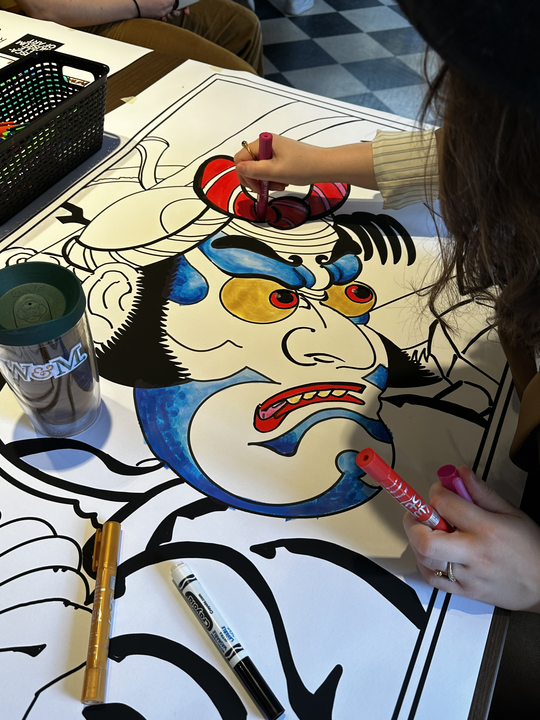Friday, March 29, the Daily Grind abounded with coloring pages, tempera paint sticks, snacks and more as Student Transition Engagement Programs and the Muscarelle, the College of William and Mary’s art museum, paired up to host an interactive event called STEP into the Arts.
STEP is known for helping organize the new student orientation program. One of its initiative directors, Talia Snyder Romero ’25, teamed up with Muscarelle intern Hannah Saad ’24 to plan this event. Although the museum is currently under construction, it has nevertheless remained active in student life and works to get involved with different programs both at and away from the College. Saad expressed that getting a chance to branch out with collaborations has been a blessing for the museum.
The event had been in the works for about six weeks, and it came about when Romero approached Saad about a potential collaboration. While an arts-themed scavenger hunt had already been planned by the Muscarelle, it was originally going to only be used for a graduate student event. However, pairing it with interactive art activities and the Daily Grind as the location proved to be a perfect way to include undergraduate students in the fun. STEP has done programs in the past for specific populations, such as low income students, international students and more, but Romero wanted this particular event to appeal to absolutely everyone.
“For this event, we wanted it to be bigger and geared towards all populations,” Romero said. “I wanted to bring people together that don’t typically consider themselves artists or engage with the arts to just take on a collaborative art piece, like these giant coloring pages. We kind of tried to gear everything to be not intimidating and not your traditional art projects.”
At the event, there were giant coloring pages that were printed, as blown-up versions of the Muscarelle’s permanent collection. By setting these up on large tables, the organizers had the hope that people would form new connections as they sat and colored next to strangers. Additionally, there were other small crafts activities, as well as a bean-bag toss outside. Complete with snacks and food, the event aimed to create a fun, cheerful environment.
The scavenger hunt concluded the event, for the purpose of helping students gain a greater appreciation for the art present at the College. Muscarelle merchandise was the prize for the scavenger hunt, and it included t-shirts, tote bags and water bottles.
“The scavenger hunt is focused around art around William and Mary’s campus. We picked out several pieces from the Muscarelle’s permanent collection, and also the president’s collection of art, that are really prominent around campus and important for students to learn about,” Saad said. “We organized a little scavenger hunt where students can go and find the actual pieces on campus that they might not have even noticed before if they’ve walked by them.”
Many attendees found themselves getting to know people they otherwise would not have met. Erin Degnan ’27, for one, attended the event with a friend, but found herself branching out and talking to other people around the coloring table.
“We’re all here working together on our cute little paintings,” Degnan said. “I think it’s nice because it’s a good way to just do something that’s not classes and not studying, and it can be very relaxing.”
Natalie Bavos-Chen ’24 enjoyed the coloring pages at the event, and she found it to be a nice break from her usual studying.
“I think there’s something really fun and relaxing and de-stressing about being able to come in and just doodle stuff,” Bavos-Chen said. “I didn’t really know what I was expecting coming into this event, but I think it’s been really fun to just draw little circles with markers, which I would not have been doing. I would have been doing my homework right now.”
As a part of STEP, one of the goals Romero focuses on is ensuring that the student body doesn’t only interact in the same small social groups, but rather reaches out to new people and through new experiences.
“The main goal of this event was to bring a couple of your friends but also to get to know other people while you’re working on a collaborative art project and to just kind of engage with the arts in ways that we don’t typically do just because as students, we’re walking around pieces of art and we don’t even typically notice it or anything like that,” Romero said. “So just having a broader awareness and appreciation for working with others, meeting others and then art as well.”
Bavos-Chen is an out-of-state student, which gives her a different perspective on the value of community-building activities such as this.
“Especially coming in as an out-of-state student, I remember being really nervous about finding a community here because college is a big transition for literally all of the different reasons that you can think of,” Bavos-Chen said. “You’re running your own life for the first time, for a lot of students. And so I think events like STEP and programs like STEP are a really great way to find a community, or network, which is so much so beneficial for every other aspect of transitioning into college.”
All in all, the event, in the eyes of attendees and organizers alike, proved to be a success, meshing together broadening social circles with a greater appreciation for the arts.

